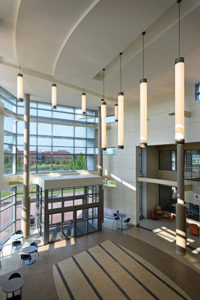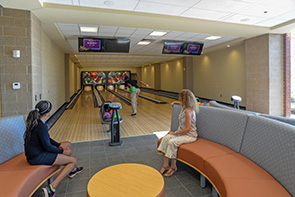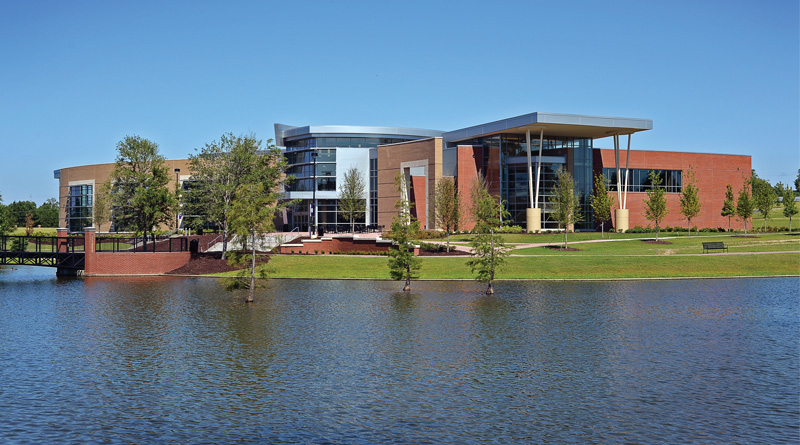New Horizons for Rec Centers & Student Unions
By Dave McCauley
Designers of campus facilities are faced with a new and challenging set of constraints. On the one hand, universities are eager to showcase new facilities as poster children for public relations. On the other, the increased reliance on student fees to contribute to the cost of construction requires design to be functional but not lavish. In addition, leaders are increasingly seeking multifunctionality as an indispensable economic value, as the following success story illustrates.
Flagship to the Future
Middle Georgia State University’s Macon campus built a recreation center, designed by Marietta, Ga.-based Lyman Davidson Dooley Inc. (LDD), that combines traditional recreation and student union elements with solutions to contemporary needs for socialization and wellness. What makes the facility unique is its strategic placement as a symbol of the university’s commitment to the future. In the 21st century, the university has been evolving from a commuter school to a more traditional campus. Facilities such as the recreation center are a visible demonstration of this evolution.
Growth has driven change. Starting as a small school, Macon State College merged with Middle Georgia College in 2012 to become Middle Georgia State College. In the summer of 2015, it became Middle Georgia State University. To convey the ambitious vision of the university, the character and appearance of new facilities will be a strong and visible key, and the recreation center is the architectural flagship of this vision.
Campus Expansion & Local Culture

Most of the current Middle Georgia campus lies on one side of a lake at the center of the campus property. The recreation center, located on the opposite and mostly undeveloped side of the lake, is connected to the main campus by a bridge. The long curving front of the building and its entrance lobby face the main campus across the lake, so that everyone on the historic side of campus has it constantly in their view. The center beckons to people to cross the bridge to its entrance.
While the lake is a prominent icon of the school’s identity when viewed from the older campus buildings, the non-student community, when passing by on Ivey Drive or Columbus Road, currently sees parking lots or the undeveloped side of the lake. Because of this, the design team had to consider how the building would appear from multiple viewpoints since there is no true back. The future campus will expand on the undeveloped side of the lake — to either side of the recreation center, and also up the hill behind it to a busy thoroughfare.
When students come onto campus now, the Recreation and Wellness Center is often one of the first buildings that they enter, a sure sign of success. The symbolic role of the bridge crossing over to the center is emphasized at the Macon Cherry Blossom Festival’s annual Tunes and Balloons event, when the campus is adorned with illuminated balloons. Thousands of people come on campus to participate and listen to live music on the open lawn around all sides of the Recreation and Wellness Center.
Programming & Vision
To start the process, planning sessions asked students at Middle Georgia State to rank the top five components they wanted to see in the new center. Then, to expand consensus, the project team continually met with administration and senior leadership, always staying in touch with student leaders, student government, the student newspaper and their internal website. These measures maintained interest and fostered both buy-in and an understanding of the design.

Photo Credit (all): Walter Elliot Photography/Courtesy
of Lyman Davidson Dooley
For example, senior faculty wanted the center to be a place for which students could feel a sense of belonging and ownership. That is, beyond the initial goal of attracting new students, the facility should also be a means of retaining them through graduation day and encouraging their return as alumni.
The school’s president, who missed only one of the preliminary design meetings, had a strong vision for the building. It was critical to balance his vision with feedback coming in from students and faculty. The president wanted the building to function, beyond athletic training activities, as a place for various types of recreation — sort of a holistic center for student life. That’s why it has a bowling alley and three stations for interactive gaming: one station for Xbox, one for Wii, and one for PlayStation.
The areas are separated by low walls that allow students to move seats around and watch others compete. A small, minimally staffed, food venue sells grab-and-go items to address the needs of today’s mobile students.
Check out the entire article in the September/October issue of School Construction News.
Dave McCauley, AIA, is director of recreation studio and principal with Lyman Davidson Dooley Inc.

